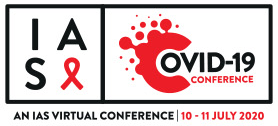HepC drugs for COVID-19: sofosbuvir/daclatasvir show faster recovery and reduced mortality
22 July 2020. Related: Conference reports, COVID-19: investigational drugs, COVID-19, IAS COVID-19 virtual 2020.

NOTE: DAAs have since been shown to NOT work against COVID-19.
Simon Collins, HIV i-Base
Tentative results from a small Iranian study using a combination of direct acting antivirals (DAAs) used to treat hepatitis C – sofosbuvir and daclatasvir (SOF/DCV) – led to faster recovery from COVID-19. In a meta-analysis with two other small studies the combination also reduced mortality.
The results were presented by Andrew Hill from Liverpool University at a press conference for the IAS COVID-19 workshop after AIDS2020. The study was presented in full by Anahita Sadeghi from Tehran University. [1]
Both drugs have shown some evidence of in-vitro or in-silico activity against SARS-CoV-2, at equivalent to standard dosing. [2, 3, 4]
The main study was an open-label multicentre trial in Tehran that randomised 66 adults hospitalised with severe PCR-confirmed COVID-19 to either SOF/DCV or standard of care, which included lopinavir/r for both arms. Other entry criteria included fever (≥37.8°C) plus at least one of: respiratory rate >24/min, O2Sat<94% or Pa02/Fi02 ratio <300mgHg. [5]
The primary outcome was clinical recovery within 14 days (defined as normalised temperature, respiratory rate or oxygen saturation) with secondary outcomes that includes all-cause mortality.
Baseline characteristics were reported as similar and included approximate median age 60 (IQR: 25 to 70), 61% vs 42% men, enrolment within 1 day of admission. Although comorbidities were also not reported as significantly different, diabetes was reported more in the active arm (52% vs 33%, p=0.213), and chronic lung disease reported less (18% vs 27%, p=0.558). Median O2 saturation was 91% vs 90%, p=0.225, also in active vs control arm respectively.
Although the percentage of participants with <14 day recovery favoured the active arm: 88% vs 67% (n=29 vs 22), this was not statistically significant (p=0.076). However, in a multivariate analysis using logistic regression (for some reason not presented) the effect was significant after adjustment for baseline characteristics (supplementary data, in press).
Time to clinical recovery, a secondary endpoint, was significantly faster in the active vs SoC arm: median 6 days (IQR: 4 to 10) vs 11 days (IQR: 6 to 17), p=0.041.
When combined in a meta-analysis (n=176) with results from two other similar size studies (the Abadan and Sari studies, n=62 and 48, respectively) time to clinical recovery significantly favoured SOF/DCV: subhazard ratio 2.03 (95% CI 1.33 to 3.08); SHR p-value <0.001. However, these studies, both also small, had different designs and also included ribavirin (one in a control arm and one with SOF/DCV).
Mortality in the meta-analysis was significantly reduced in the SOF/DCV arm: 5.4 % (5/92) vs 20% (17/84), p=0.013.
comment
These are small studies and design differences also caution the interpretation of results from the meta-analysis. The tentative results also clearly need to be supported by larger randomised clinical studies, but one of these (n=600) is already underway. [6]
Although both drugs are still in-patent high-cost medicines (approx. list price $18,000 and $7,000 for a 14-day treatment in the US and UK respectively), generic versions of a combined dual formulation are available for $7 or less. [7, 8]
The study has also been selected as one of five clinical highlights selected by Anthony Fauci from the IAS virtual COVID-19 workshop that will take place directly after AIDS2020. [9]
References
- Wentzel et al. Sofosbuvir and daclatasvir for the treatment of COVID-19: Results from a randomised controlled trial. IAS COIVD-19 Conference, 10-11 July 2020.
https://cattendee.abstractsonline.com/meeting/9307/presentation/3933 - Elfiky AA et al. Quantitative structure-activity relationship and molecular docking revealed a potency of anti-hepatitis C virus drugs against human corona viruses. J Med Virol 2017; 89: 1040-7.
https://pubmed.ncbi.nlm.nih.gov/27864902 - Beck BR et al. Predicting commercially available antiviral drugs that may act on the novel coronavirus (SARS-CoV-2) through a drug-target interaction deep learning model. Comput Struct Biotechnol J 2020; 18: 784-90.
https://www.biorxiv.org/content/10.1101/2020.01.31.929547v1 - Sacramento CQ et al. The in vitro antiviral activity of the anti-hepatitis C virus (HCV) drugs daclatasvir and sofosbuvir against SARS-CoV-2. bioRxiv. 2020 [preprint].
https://www.biorxiv.org/content/10.1101/2020.06.15.153411v1 - Iranian Trial Registry. A prospective randomized controlled trial comparing antiviral Sovodak (sofosbuvir+daclatasvir) in participants with moderate to severe Coronavirus disease (COVID-19) compared to standard of care treatment.IRCT20200128046294N2.
https://en.irct.ir/trial/46463 - Iranian Trial Registry. Evaluation of the effect of sofosbuvir/daclatasvir in COVID-19 patients: A randomized double-blind clinical trial (DISCOVER study).
https://en.irct.ir/trial/49198 - Hill A et al. Minimum costs to manufacture new treatments for COVID-19. J Virus Erad 2020; 6: 61-9.
https://www.ncbi.nlm.nih.gov/pmc/articles/PMC7213074 - Clayden P. Potential treatments for COVID-19 could be manufactured for $1 a day or less. HTB (17 April 2020).
https://i-base.info/htb/37606 - Fauci A. IAS COVID-19 workshop. 10-11 July 2020.
This article was first posted on 9 July 2020.

